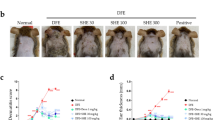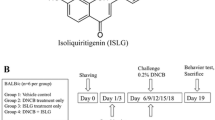Abstract
Atopic dermatitis (AD) is a chronic skin inflammatory disease characterized by uncontrolled Th2 cells response to environmental allergens. Long-term topical application of corticosteroids for treating AD may induce severe side effects. Sulfuretin is a major flavonoid found in Rhus verniciflua and carries antioxidant and anti-inflammatory properties. Its therapeutic effect on AD has not been characterized. We first studied the cytotoxic and regulatory effects of sulfuretin on differentiated Th2 cells. Next, we evaluated therapeutic effect of sulfuretin on AD-like damages caused by 2,4-dinitrochlorobenzene (DNCB) in a mouse model. Serum IgE level, overall symptomatic score, and cytokine accumulation at the lesions were measured. Lastly, we investigated the regulatory mechanism of sulfuretin on GATA3 pathway in primary mouse CD4+ cells. Study on in vitro differentiated Th2 cells showed sulfuretin inhibited IL4 production in dose-dependent manner without any cytotoxicity. In vivo study showed 10 μM sulfuretin alleviated the AD symptoms including skin lesion severity, scratching incidence, IgE serum level, and proinflammatory cytokine accumulation at local skin lesion site. Mechanistic study suggested sulfuretin attenuated Th2 cytokine production by suppressing GATA3 expression. Our results demonstrate that sulfuretin could be used as therapeutic application for treating AD.





Similar content being viewed by others
References
Bieber T. Atopic dermatitis. Ann Dermatol. 2010;22:125–37. https://doi.org/10.5021/ad.2010.22.2.125.
Leung DY, Boguniewicz M, Howell MD, Nomura I, Hamid QA. New insights into atopic dermatitis. J Clin Invest. 2004;113:651–7. https://doi.org/10.1172/JCI21060.
Weidinger S, Novak N. Atopic dermatitis. Lancet. 2016;387:1109–22. https://doi.org/10.1016/S0140-6736(15)00149-X.
Werfel T, Allam JP, Biedermann T, Eyerich K, Gilles S, Guttman-Yassky E, et al. Cellular and molecular immunologic mechanisms in patients with atopic dermatitis. J Allergy Clin Immunol. 2016;138:336–49. https://doi.org/10.1016/j.jaci.2016.06.010.
Liu FT, Goodarzi H, Chen HY. IgE, mast cells, and eosinophils in atopic dermatitis. Clin Rev Allergy Immunol. 2011;41:298–310. https://doi.org/10.1007/s12016-011-8252-4.
Jin H, He R, Oyoshi M, Geha RS. Animal models of atopic dermatitis. J Invest Dermatol. 2009;129:31–40. https://doi.org/10.1038/jid.2008.106.
Chan LS, Robinson N, Xu L. Expression of interleukin-4 in the epidermis of transgenic mice results in a pruritic inflammatory skin disease: an experimental animal model to study atopic dermatitis. J Invest Dermatol. 2001;117:977–83. https://doi.org/10.1046/j.0022-202x.2001.01484.x.
Schmid-Grendelmeier P, Ballmer-Weber BK. Atopic dermatitis - current insights into path physiology and management. Ther Umsch. 2010;67:175–85. https://doi.org/10.1024/0040-5930/a000031.
Heratizadeh A, Werfel T. Anti-inflammatory therapies in atopic dermatitis. Allergy. 2016;71:1666–75. https://doi.org/10.1111/all.13065.
Bieber T, D’Erme AM, Akdis CA, Traidl-Hoffmann C, Lauener R, Schappi G, et al. Clinical phenotypes and endophenotypes of atopic dermatitis: where are we, and where should we go? J Allergy Clin Immunol. 2017;139:S58–64. https://doi.org/10.1016/j.jaci.2017.01.008.
Lee DS, Jeong GS, Li B, Park H, Kim YC. Anti-inflammatory effects of sulfuretin from Rhus verniciflua Stokes via the induction of heme oxygenase-1 expression in murine macrophages. Int Immunopharmacol. 2010;10:850–8. https://doi.org/10.1016/j.intimp.2010.04.019.
Song MY, Jeong GS, Lee HS, Kwon KS, Lee SM, Park JW, et al. Sulfuretin attenuates allergic airway inflammation in mice. Biochem Biophys Res Commun. 2010;400:83–8. https://doi.org/10.1016/j.bbrc.2010.08.014.
Roh K, Kim S, Kang H, Ku JM, Park KW, Lee S. Sulfuretin has therapeutic activity against acquired lymphedema by reducing adipogenesis. Pharmacol Res. 2017;121:230–9. https://doi.org/10.1016/j.phrs.2017.05.003.
Liu CS, Nam TG, Han MW, Ahn SM, Choi HS, Kim TY, et al. Protective effect of detoxified Rhus verniciflua stokes on human keratinocytes and dermal fibroblasts against oxidative stress and identification of the bioactive phenolics. Biosci Biotechnol Biochem. 2013;77:1682–8. https://doi.org/10.1271/bbb.130236.
Gutermuth J, Ollert M, Ring J, Behrendt H, Jakob T. Mouse models of atopic eczema critically evaluated. Int Arch Allergy Immunol. 2004;135:262–76. https://doi.org/10.1159/000082099.
Martel BC, Lovato P, Baumer W, Olivry T. Translational animal models of atopic dermatitis for preclinical studies. Yale J Biol Med. 2017;90:389–402.
Matsuda H, Watanabe N, Geba GP, Sperl J, Tsudzuki M, Hiroi J, et al. Development of atopic dermatitis-like skin lesion with IgE hyperproduction in NC/Nga mice. Int Immunol. 1997;9:461–6.
Yuan XY, Liu W, Zhang P, Wang RY, Guo JY. Effects and mechanisms of aloperine on 2, 4-dinitrofluorobenzene-induced allergic contact dermatitis in BALB/c mice. Eur J Pharmacol. 2010;629:147–52. https://doi.org/10.1016/j.ejphar.2009.12.007.
Boguniewicz M, Leung DY. Atopic dermatitis: a disease of altered skin barrier and immune dysregulation. Immunol Rev. 2011;242:233–46. https://doi.org/10.1111/j.1600-065X.2011.01027.x.
Lee YR, Hwang JK, Koh HW, Jang KY, Lee JH, Park JW, et al. Sulfuretin, a major flavonoid isolated from Rhus verniciflua, ameliorates experimental arthritis in mice. Life Sci. 2012;90:799–807. https://doi.org/10.1016/j.lfs.2012.04.015.
Kwon SH, Ma SX, Hwang JY, Lee SY, Jang CG. Involvement of the Nrf2/HO-1 signaling pathway in sulfuretin-induced protection against amyloid beta25-35 neurotoxicity. Neuroscience. 2015;304:14–28. https://doi.org/10.1016/j.neuroscience.2015.07.030.
Rengarajan J, Szabo SJ, Glimcher LH. Transcriptional regulation of Th1/Th2 polarization. Immunol Today. 2000;21:479–83.
Zhu J, Min B, Hu-Li J, Watson CJ, Grinberg A, Wang Q, et al. Conditional deletion of Gata3 shows its essential function in T(H)1-T(H)2 responses. Nat Immunol. 2004;5:1157–65. https://doi.org/10.1038/ni1128.
Leung DY. Atopic dermatitis: new insights and opportunities for therapeutic intervention. J Allergy Clin Immunol. 2000;105:860–76. https://doi.org/10.1067/mai.2000.106484.
Kawai M, Hirano T, Higa S, Arimitsu J, Maruta M, Kuwahara Y, et al. Flavonoids and related compounds as anti-allergic substances. Allergol Int. 2007;56:113–23. https://doi.org/10.2332/allergolint.R-06-135.
Chirumbolo S. Quercetin as a potential anti-allergic drug: which perspectives? Iran J Allergy Asthma Immunol. 2011;10:139–40.
Matsumoto M, Kotani M, Fujita A, Higa S, Kishimoto T, Suemura M, et al. Oral administration of persimmon leaf extract ameliorates skin symptoms and transepidermal water loss in atopic dermatitis model mice, NC/Nga. Br J Dermatol. 2002;146:221–7.
Kotani M, Matsumoto M, Fujita A, Higa S, Wang W, Suemura M, et al. Persimmon leaf extract and astragalin inhibit development of dermatitis and IgE elevation in NC/Nga mice. J Allergy Clin Immunol. 2000;106:159–66. https://doi.org/10.1067/mai.2000.107194.
Author information
Authors and Affiliations
Corresponding author
Ethics declarations
All experimental studies involving animals were approved by the Institutional Animal Care and Use Committee (IACUC) of Wuxi No.2 People’s Hospital.
Conflict of interest
The authors declare that they have no conflict of interest.
Research involving human participants and/or animals
All applicable international, national, and/or institutional guidelines for the care and use of animals were followed.
Informed consent
Not applicable.
Rights and permissions
About this article
Cite this article
Jiang, P., Sun, H. Sulfuretin alleviates atopic dermatitis-like symptoms in mice via suppressing Th2 cell activity. Immunol Res 66, 611–619 (2018). https://doi.org/10.1007/s12026-018-9025-4
Published:
Issue Date:
DOI: https://doi.org/10.1007/s12026-018-9025-4




